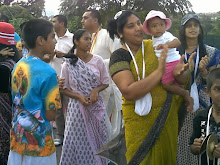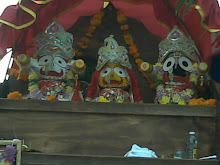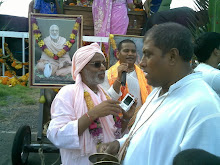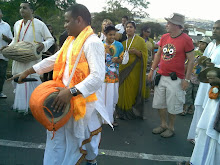Haribol All
All Glories to Srila Gurudeva,Jai Sacinandana
Tomorrow is beginning of Caturmasya and
Eclipse.I`m attaching some information
on both events.Also some info on Ekadasi.
Monday, 26 January 2009
The 2009-10 Vaisnava Calendar (Panjika) has been made in accordance with the rules for making exact solar and lunar calculations as delineated in Hari-bhakti-vilasa by Sri Sanatana Gosvami, and as followed by Sri Srimad Bhaktivedanta Narayana Gosvami Maharaja in the various locations he visits during his worldwide preaching.
Break Fast Times: As in last year's calendar, the parana, or exact times within which to break a fast, is listed according to location. You will note that these times vary considerably. This is due to a location's latitude, longitude, and time of year.
Such times are marked by the words: Break fast times. For example, Amsterdam (06:53-10:51) informs a person in Amsterdam to break his fast between 6.53am and 10.51am
Daylight Savings Time: Daylight savings time (DST) not considered. This means that the exact break fast and eclipse times given herein does not take Daylight Savings Time into account. The reader is therefore advised to add the DST difference for the local time zone (usually one hour ) when DST is in effect (during summer months). For example, 09:01 am becomes 10:01 am. When DST is not in effect, simply observe the local break fast or eclipse times as listed.
It is the desire of Sri Srimad Bhaktivedanta Narayana Gosvami Maharaja that the calculations for the individual time zones around the world be followed.
Calculations: In the previous year calendar, the calculations for the positions of the sun and moon were made from the center of the earth (geocentric). In this year's calendar, under the guidance of Srila Bhaktivedanta Narayana Gosvami Maharaja (Srila Gurudeva), the calculations are being made from the surface of the earth for each location. Due to this difference, you may find that this calendar will vary slightly from other vaisnava calendars that are using geocentric calculations.
Maha-dvadasi: There are eight special conditions when a dvadasi lunar tithi becomes a Maha-dvadasi. In such cases, fasting is done on the Maha-dvadasi and not the ekadasi. A Maha-dvadasi may be in effect for one location and not another. A regular dvadasi can also become a fast day for an ekadasi under certain conditions. Please pay attention to the fasting instructions for each location which are listed under the location name.
Eclipses: This year we have included worldwide eclipse times. Please see rules to be followed during eclipses below.
Special Festival Days: The Gaudiya Vaisnavas observe the appearance days of Visnu tattva incarnations of Lord Sri Krsna by fasting on those days (no grains): Sri Advaita Acarya, Lord Sri Nityananda Prabhu, Sri Caitanya Mahaprabhu, Lord Sri Ramacandra, Lord Sri Nrsimhadeva, Lord Sri Balarama, Lord Sri Krsna. For the festival days of Lord Varahadeva and Lord Vamanadeva which are on a dvadasi tithi, fasting is done on the dvadasi when it becomes a maha-dvadasi, else fasting is done the day before on ekadasi.
For more details and explanations about the different festivals and appearance and disappearance days, information about the various programs and festivities in your local area and around the world, or to view transcendental art and lectures online, please visit our website: www.purebhakti.com
Rules for Observing Ekadasi Fast and Break Fast
If you have observed a complete fast (meaning, you have not even taken water on Ekadasi day) you do not need to break the fast the following day with grains. You can break it with caranamrita (Krsna's foot bathing water) or fruit at the times mentioned herein. But if on Ekadasi you took fruit, vegetables, etc. then you should break it with grains next morning at the proper times listed for paran.
Maha-dvadasi is observed like Ekadasi when listed for your location.
Ekadasi
The essence of Ekadasi is to spend as much time as possible hearing, chanting and remembering Sri Sri Radha-Krsna. Therefore, on that day, it is recommended that one eat simply, only once or twice. Never eat meat, fish, eggs, onions, garlic, carrots, red lentils (masur dahl) green flat lentils, mushrooms or products thereof.
Restricted foods on Ekadasi:
Tomatoes, eggplants, cauliflower, broccoli, bell peppers, beets, bitter melon (karela), loki, parmal, toroi, kunli, drumsticks, bindi (ladies' fingers) and banana flowers
Peas, chickpeas and all types of beans, including products made from beans (e.g., papadams, tofu, tempeh and other soy products)
All leafy vegetables (e.g., spinach, salads, cabbages) and leafy herbs like parsley, coriander leaves, celery, curry leaves etc.
Grains (e.g., millet, barley, farina, pasta, rice, corn & quinoa) and all types of flour made from grains and beans (e.g., rice flour, chickpea flour, urad dahl flour) Buckweat is allowed on ekadasi
Starches from corn or grains, and products made from or mixed with these starches like baking soda, baking powder, certain soft drinks with corn syrup, custard, certain yoghurts and puddings, certain varieties of cream and cottage cheese, certain sweets and candies, and tapioca balls which often mixed with rice powder.
Oils made from grains (e.g., corn oil, mustard oil, soybean oil, sesame oil and general vegetable oil) and products fried in these oils (e.g., fried nuts, potato chips and other fried snack foods)
Honey, and sweets made with starches
Spices used only on Ekadasi:
Fresh ginger, fresh turmeric, black pepper powder, pure salt (preferably rock salt) taken from a new and clean package
All other spices are not used on Ekadasi: (for example: hing (asafotida), cumin, fenugreek, mustard, tamarind, fennel, cardamom, kalanji, nutmeg etc...
Foods that can be taken all days of the year, including Ekadasi and Caturmasya:
All fruits (fresh and dried), all nuts and all oils made from nuts
Potatoes, pumpkin, cucumber, radish, squash, lemon, avocado, olives, coconut, buckwheat, all sugars
All pure milk products (except yoghurt during the 2nd month of Caturmasya and milk during the 3rd month)
For sannyasis, brahmacaris and vanaprasthas: shaving head and cutting nails is to be done on full moon days only.
Caturmasya
Restricted foods during the entire four months of Caturmasya:
Eggplants, tomatoes (if possible), loki, parmal, urad dahl, honey
Particular foods that are restricted during each of the four months:
First month: No leafy vegetables, such as spinach, salads of all types, cabbages of all types, kale, leafy herbs like coriander, mint, parsley, curry and powdered leafy herbs and teas
Second month: No yoghurt (if one requires it for health, it can be mixed with some water)
Third month: No milk (if required, it can be mixed with a drop of lemon juice)
Fourth month: No Urad dahl, mustard seeds, mustard oil, sesame seeds and sesame oil.
Eclipses
There are three types of eclipses: total, partial, and penumbral.
Eclipses are considered inauspicious. To counteract inauspicious effects and to create auspiciousness, during an eclipse one avoids sleeping, eating, drinking, bathing or using the bathroom. It is recommended to stay indoors, not to look at the eclipse, and constantly chant Harinama.
Eclipses will be listed for your location. It is possible that an eclipse may not be visible, or it may be only partially visible from your location. To check eclipse visibility maps, see the Nasa Eclipse website at eclipse.gsfc.nasa.gov. If an eclipse is not visible in your location, it is not necessary to observe it. However, it is still considered an inauspicious time. Although you may find eclipse viewing instructions at the above website, Gaudiya Vaisnavas do not recommend viewing eclipses.
_uacct = "UA-3182533-1";
urchinTracker();
Subscribe to:
Post Comments (Atom)










-001.jpg)
-001.jpg)
-001.jpg)
-001.jpg)

-001.jpg)
-001.jpg)


No comments:
Post a Comment